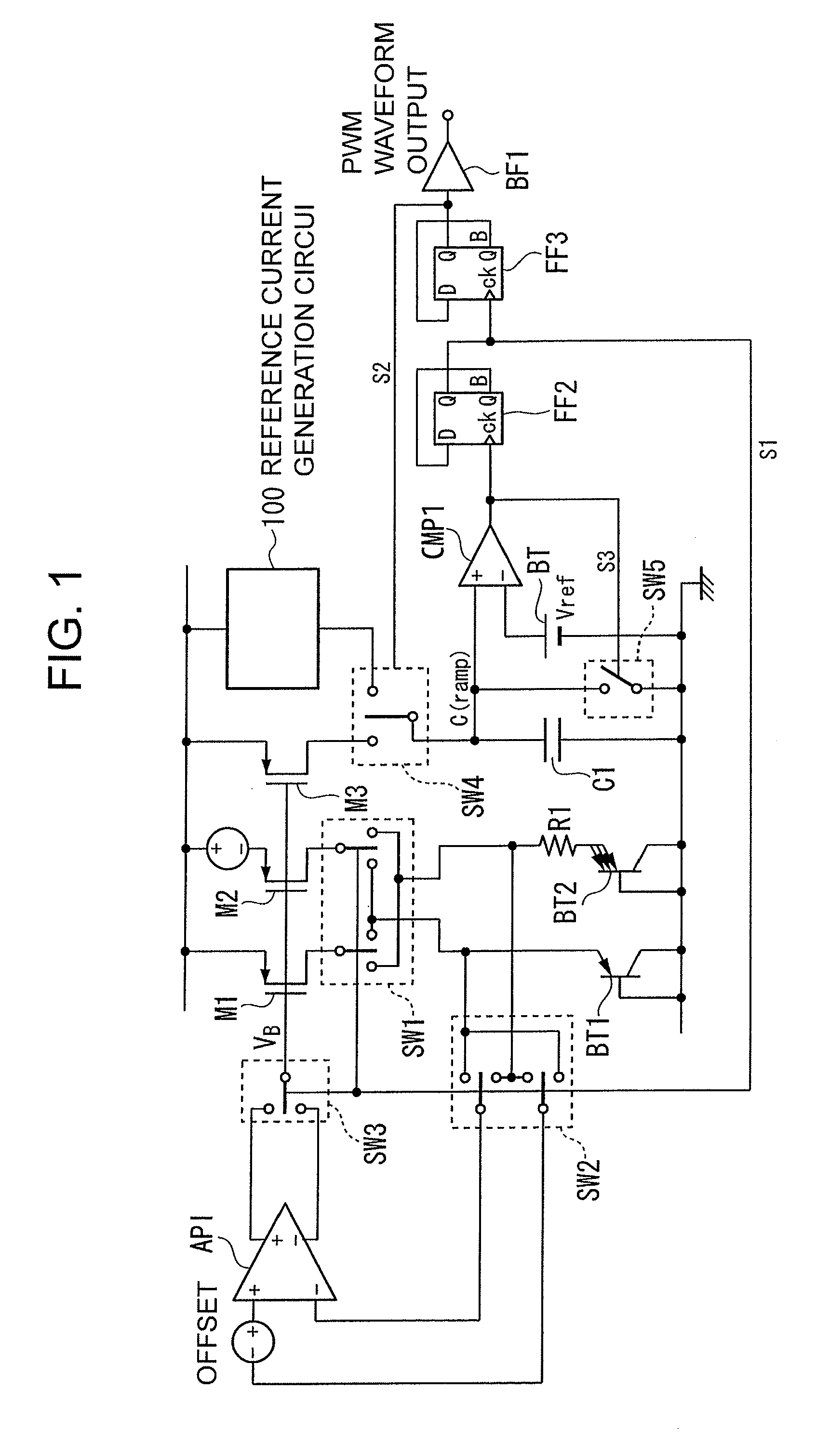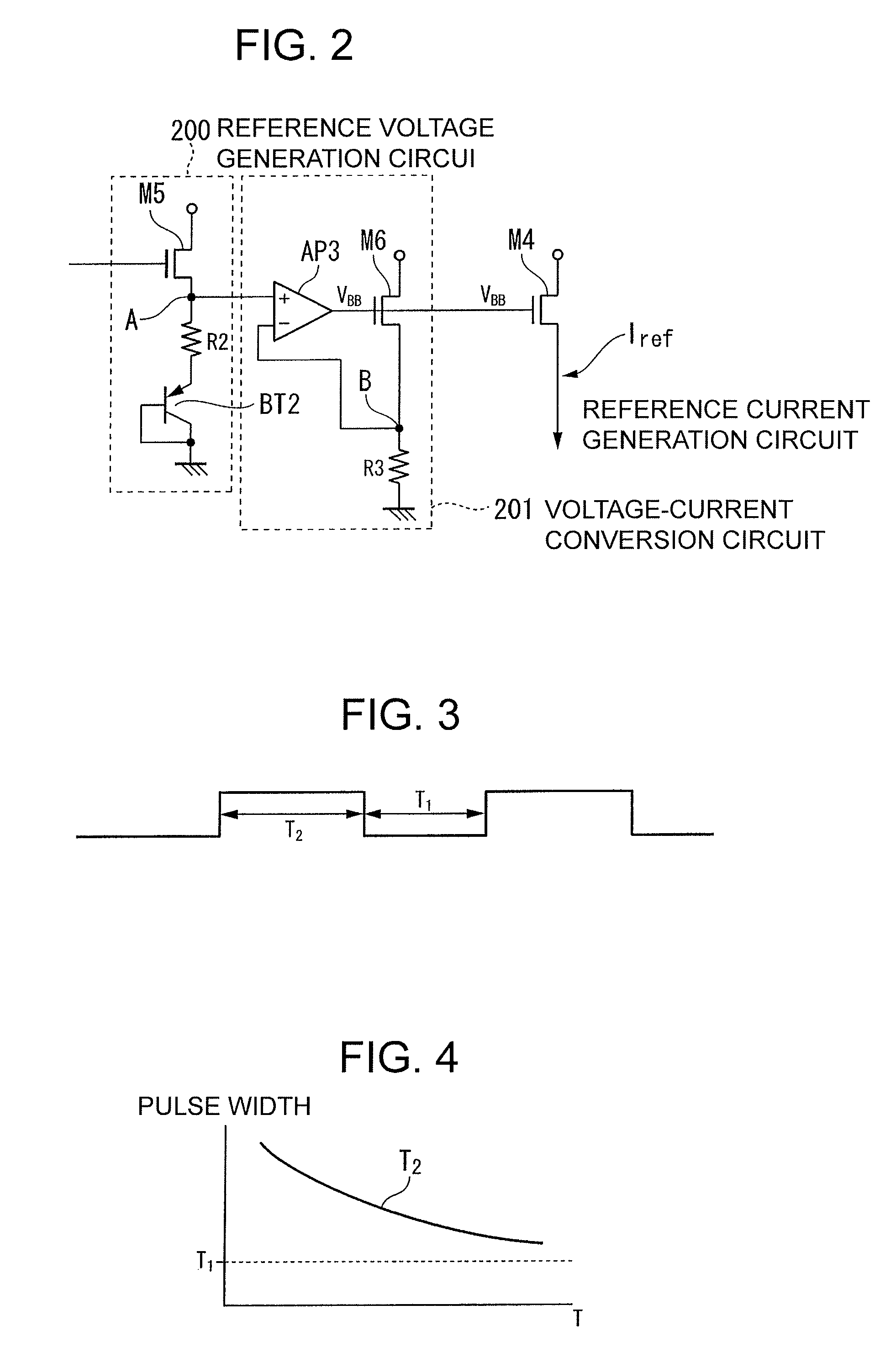Temperature sensor
a temperature sensor and sensor technology, applied in the field of temperature sensors, can solve the problems of inability to generate pulse width that is accurately dependent on temperature, deviating from its theoretical value, and low precision of temperature measurement, and achieve the effect of precise temperature measuremen
- Summary
- Abstract
- Description
- Claims
- Application Information
AI Technical Summary
Benefits of technology
Problems solved by technology
Method used
Image
Examples
first embodiment
[0037]Hereinafter, referring to the accompanying drawings, a temperature sensor according to a first embodiment of the present invention is described. FIG. 1 is a block diagram illustrating a configuration example of the temperature sensor according to the first embodiment of the present invention.
[0038]In FIG. 1, P-channel MOS transistors M1 and M2 form a current source circuit. Each of the MOS transistors M1 and M2 has a source applied with a power supply voltage. Further, a P-channel MOS transistor M3, which is described later, has a gate applied with the same bias voltage as that applied to gates of the MOS transistors M1 and M2 forming the current source circuit described above, to thereby establish a current source connection.
[0039]A bipolar transistor BT1 is a PNP bipolar transistor connected as a load of one of the above-mentioned MOS transistors M1 and M2.
[0040]A bipolar transistor BT2 is a PNP bipolar transistor connected as a load of another one of the MOS transistors M1 ...
second embodiment
[0132]Next, referring to the accompanying drawings, a temperature sensor according to a second embodiment of the present invention is described. FIG. 6 is a block diagram illustrating a configuration example of the temperature sensor according to the second embodiment of the present invention.
[0133]The same component as that of FIG. 1 illustrating the first embodiment is denoted by the same reference symbol, and description thereof is omitted. Hereinafter, only a configuration and an operation according to the second embodiment different from those of the first embodiment are described.
[0134]A newly-added component is a flip-flop FF5.
[0135]The flip-flop FF5 is provided at a subsequent stage of the flip-flop FF3. A data terminal D and an output terminal QB of the flip-flop FF5 are connected with each other so that the flip-flop FF5 may function as a toggle flip-flop. The flip-flop FF5 has a clock terminal CK that is connected to the output terminal Q of the flip-flop FF3 and receives...
third embodiment
[0153]Next, referring to the accompanying drawings, a temperature sensor according to a third embodiment of the present invention is described. FIG. 8 is a block diagram illustrating a configuration example of the temperature sensor according to the third embodiment of the present invention.
[0154]The same component as that of FIG. 6 illustrating the second embodiment is denoted by the same reference symbol, and description thereof is omitted. Hereinafter, only a configuration and an operation according to the third embodiment different from those of the second embodiment are described.
[0155]In the third embodiment of the present invention, a newly-added component is a selection switch SW6.
[0156]Further, in the third embodiment, a capacitor C1A and a capacitor C1B are provided instead of the capacitor C1 according to the second embodiment. Similarly, a selection switch SW4A and a selection switch SW4B are provided instead of the selection switch SW4 according to the second embodiment...
PUM
 Login to View More
Login to View More Abstract
Description
Claims
Application Information
 Login to View More
Login to View More - R&D
- Intellectual Property
- Life Sciences
- Materials
- Tech Scout
- Unparalleled Data Quality
- Higher Quality Content
- 60% Fewer Hallucinations
Browse by: Latest US Patents, China's latest patents, Technical Efficacy Thesaurus, Application Domain, Technology Topic, Popular Technical Reports.
© 2025 PatSnap. All rights reserved.Legal|Privacy policy|Modern Slavery Act Transparency Statement|Sitemap|About US| Contact US: help@patsnap.com



